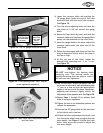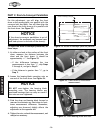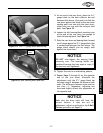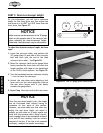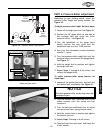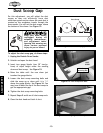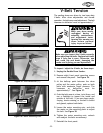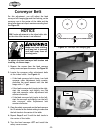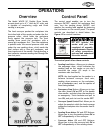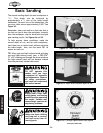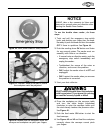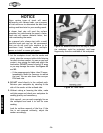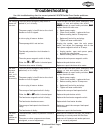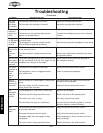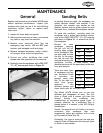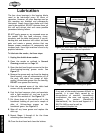
-23-
OPERATIONS
Control Panel
The control panel enables you to turn the
conveyor ON/OFF, control the workpiece feed
rate, turn the sanding drums ON/OFF, and
monitor the sanding load applied by observing
the load meter on the control panel. The panel
controls are described in detail below. See
Figure 42 for control locations.
DO NOT operate this
sander until you have
completed all assembly,
and adjustments. Observe
all safety precautions,
and read and understand
this entire manual.
INSTRUCTION MANUAL
MODEL W1678
26" DOUBLE DRUM SANDER
Phone: 1-360-734-3482 • On-Line Technical Support: tech-support@shopfox.biz
COPYRIGHT © MARCH, 2003 BY WOODSTOCK INTERNATIONAL, INC.
WARNING: NO PORTION OF THIS MANUAL MAY BE REPRODUCED IN ANY SHAPE OR FORM WITHOUT
THE WRITTEN APPROVAL OF WOODSTOCK INTERNATIONAL, INC.
Printed in Taiwan
Figure 42. Control Panel.
The control panel offers these controls:
• Sanding Load Meter: Allows you to observe
the amperage draw, which indicates the
sanding load on the sander so you don’t
overload the motor (25 amps is the
maximum safe load limit).
NOTE: the load applied on the sander is a
balance between conveyor feed rate,
sanding drum pressure on the workpiece,
grit of sandpaper used, and the species of
wood being sanded.
• Emergency Stop Button: Allows you to turn
the main power ON or OFF to the double
drum sander, and shut down the machine in
an emergency. Twist clockwise and pull to
turn ON, and push to turn the sander OFF.
• Conveyor Speed Control Dial: Allows you to
adjust the speed at which the feed conveyor
pushes the workpiece into the sander from 0-
20 FPM.
• Sanding Drum Motor ON and OFF Buttons:
Allows you to turn the sanding drums ON or
OFF independently of the conveyor.
• Conveyor Motor ON and OFF Buttons:
Allows you to turn the conveyor belt ON or
OFF independently of the sanding drums.
Overview
The Model W1678 26" Double Drum Sander
accepts stock up to 4
1
⁄2"thick by 26" wide, and
is capable of completing rough and finish
sanding in one pass.
The feed conveyor pushes the workpiece into
the infeed side of the sander and under the first
pressure roller, which holds the workpiece
firmly against the conveyor belt. The front
sanding drum sands the workpiece with a
coarse-grit sandpaper first. Then the workpiece
is pushed under the second pressure roller and
under the rear sanding drum, which sands the
final surface with a finer-grit sandpaper, and
then travels out of the sander. During sanding, a
dust collector removes sanding dust through the
two dust ports.
ADJUSTMENTS



